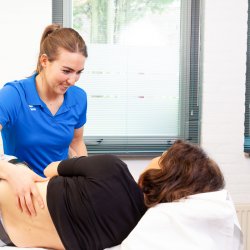the ultimate glossary of terms about fysiopraktijk fysio bruggeman

Physical treatment as well as workout is normally an essential part of the treatment prepare for sacroiliac joint disorder discomfort alleviation and also healing. The sacroiliac joint, which attaches the spine to every hip, can create discomfort in the reduced back, pelvis, groin, and/or legs because of uncommon movement at the joint. An estimated 15% to 30% of low back pain instances come from at the sacroiliac joint.1 Most discomfort that stems from the sacroiliac joint, also called the SI joint, can be handled or dealt with utilizing nonsurgical methods, consisting of physical therapy, control and workout.
This article previews a well-rounded workout program for SI joint discomfort alleviation, which typically consists of a mix of muscle mass stretches, strengthening exercises, and also certain types of cardiovascular exercise that raise heart rate and advertise flow of recovery nutrients.
Sacroiliac Joint Makeup as well as Function
Prior to beginning an exercise program, it is valuable to comprehend the composition and function of the sacroiliac joint. The back component of the sacroiliac joint consists of a network of https://fysiobruggeman.nl/bekkenklachten/ strong ligaments that extend throughout the joint to provide additional assistance as well as stability.
The main feature of the sacroiliac joint is to take in stress transmitted between the top as well as reduced body. The SI joint aids absorb shock put on the lower body with movements such as walking, running, or leaping to reduce the stress felt in the reduced spinal column.
The joint typically has very little motion, enabling small activities to support the hips when walking, flexing ahead or backward, as well as turning the spine.
Exactly How Workout Can Alleviate SI Joint Pain
A collection of extending and enhancing exercises might be prescribed to help in reducing sacroiliac joint discomfort. These workouts are made to recover natural movement of the joint, by relaxing tense muscular tissues and also tendons that restrict natural activity at the joint or conditioning the surrounding muscles and ligaments to better sustain the joint.
Since a variety of muscle mass support the SI joint, workouts may target the hips along with the reduced back, groin, hamstring and also upper leg, and/or stomach muscles.
Aerobic exercise is a necessary aspect of any kind of workout program. The goal of cardio exercise is to raise the heart rate for a minimum of 20 mins. The improved flow from aerobic workout provides a series of nutrients and oxygen throughout the body, promoting the healing process in weakened or hurt soft tissues in the sacroiliac joint.
It is advised that a doctor or physiotherapist knowledgeable about the patient's particular needs is gotten in touch with prior to beginning a brand-new exercise program. A prior examination makes sure that a brand-new exercise will not create further worsening of discomfort.
It is common to match rehabilitative exercise with various other treatments as well as discomfort monitoring approaches for optimal pain alleviation. Extra therapies might include pain medicines, warmth or ice application, hands-on adjustment.
SI Joint Pain Alleviation Considerations
If discomfort does not enhance within 2 to 3 weeks of extending, reinforcing, and also aerobic exercise, control (also called chiropractic care) should be thought about by a trained Osteopath (DO), Chiropractor (DC) or Physiotherapist (PT).
If this treatment does not help settle the pain, further diagnostic devices might be taken into consideration, consisting of x-ray and also possible ultrasound- or fluoroscopic-guided shot right into the SI joint. An injection examination includes a local anesthetic integrated with steroid or Plasma Abundant Platelets (PRP). If the anesthetic briefly soothes the person's discomfort, it validates that the sacroiliac joint is the pain resource. In addition to diagnostic help, an injection can likewise provide momentary discomfort relief.
Tension in the soft cells of the pelvis, groin, reduced back, as well as thighs can put excess pressure on the sacroiliac joint, causing or exacerbating discomfort. Stretches targeted for certain muscles or muscle mass groups can help relieve SI joint discomfort and recover some series of activity to the legs, hips, and lower back.
There are numerous muscular tissues that originate at the sacrum or hip bones (the iliac crests), and also these muscle mass assist offer stability for the pelvis. Decreasing tension in these muscle mass can lower pressure on the sacroiliac joint and throughout the reduced back.
Hold the stretch for 15 to 30 seconds, after that alternate legs to stretch both hamstrings 5 times. There are a number of ways to securely and also effectively extend the hamstrings; which extend works best is frequently a matter of individual choice.

To extend the quadriceps in the front of the thigh, stand with one arm versus a wall for support. Draw the appropriate upper hand behind the body, bent at the knee, and comprehend the foot or ankle joint with the right hand. Hold this go for 15 to 30 secs, then repeat on the left side. Alternative legs to extend the quadriceps 2 times each.
The hip adductor muscles in the inside of the thighs aid draw the legs in toward the middle of the body, as well as connect to the upper legs from bones in the pelvis. To extend these muscles as well as decrease stress on the SI joint, sit with the legs straight and also apart to form a triangle, then gently lean onward toward the toes. Hold this stretch for 5 to 10 seconds, as well as slowly build up to holding for 15 to 30 secs.
Lying on the belly, elevate the upper body to the elbows and hold for 15 to 30 secs to stretch muscles in the reduced abdominal area as well as front of the pelvis. For best outcomes, attempt to maintain the shoulders unwinded, down, and away from the ears while loosening up the muscles in the lower back and buttocks. Start this go for 5 secs, then accumulate to 15 to 30 secs. Repeat 5 to 10 times. For a more advanced press-up, elevate the top body to the hands with joints straight.
Pushing the back, draw one knee up towards the chest while keeping the various other leg straight and also touching the ground. Cross the fingers behind the thigh and carefully press the knee down, holding the stretch for 5 seconds. Repeat this stretch on both sides 5 to 10 times.





Ingen kommentarer endnu